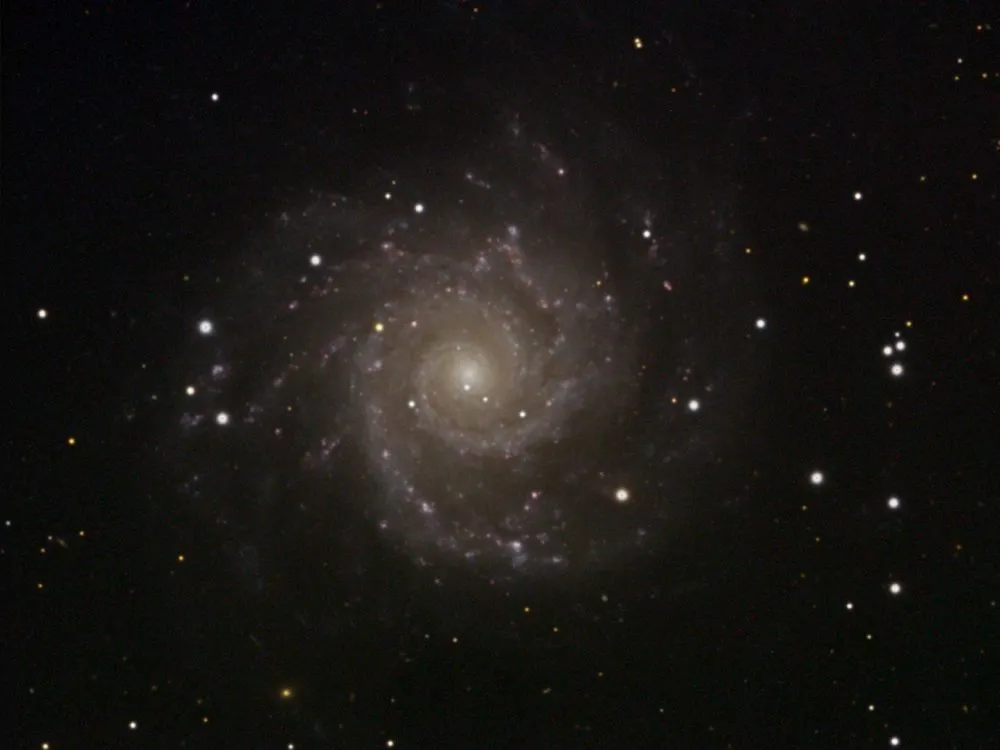Aries is a small but historic constellation best seen in the Northern Hemisphere during autumn and winter, and in the Southern Hemisphere during spring and summer.
In classical astronomy, it represents the ram with the golden fleece, a figure from Greek mythology.
- Discover our pick of the best constellations, season by season

Aries may not be the brightest or largest constellation, but it's easy to spot when you know where to look.
Get weekly stargazing advice by signing up to our e-newsletter and subscribing to our YouTube channel

The brightest star in Aries is Hamal, which shines at magnitude +2.0.
Hamal means ‘the lamb’ and it’s the 50th brightest star in the sky.
Along with Sheratan and Mesartim, it forms a curved line that outlines the ram’s head.

Aries, the zodiac and the planets
Aries is one of the zodiac constellations and you'll find it between fellow zodiac constellations Pisces and Taurus.
It's located along the ecliptic, which represents our view of the plane of the Solar System, as seen from Earth.

As a result, the planets of the Solar System such as Mars, Jupiter or Uranus, may sometimes be seen within the boundary of Aries.
In fact, in 2025 NASA released an image captured by the Psyche spacecraft, 290 million km (180 million miles) away, in which Earth and our Moon could be seen in Aries!

Deep-sky objects in Aries
Aries isn’t generally regarded as a rich haven for amateur deep-sky jewels.
However, there are a few beautiful galaxies that can be seen near the Aries–Pisces border.
We asked The Sky at Night's resident astronomer Pete Lawrence to pick out six such galaxies.
For help finding them, download our Aries-Pisces galaxy chart.
1 – NGC 697

Our first target is NGC 697, a 13th-magnitude galaxy 1.7° north-northwest of mag. +2.6 Sheratan (Beta (β) Arietis). Alternatively, locate mag. +5.8 1 Arietis and you’ll find NGC 697 0.3° to the east.
It can be seen through a 150mm scope, but it’ll be a struggle, right on the edge of visibility. Larger scopes show it as a faint elongated glow 1.5–2.0 arcminutes long and roughly half that size wide.
2 – NGC 691

We can use 1 Arietis to find our next target, the unbarred spiral galaxy NGC 691. First, take a moment to look at 1 Arietis. It’s a beautiful double, consisting of a deep-yellow mag. +6.4 primary and a mag. +7.2 light-blue secondary, 2.9 arcseconds apart. Head 1.5° south from 1 Arietis to find mag. +11.6 NGC 691, visible with a 150mm scope as a circular patch.
A 250mm or larger scope reveals the object to be around 2 arcminutes across and flattened into a wide oval. There’s the vaguest hint of brightening towards the core, but overall, its appearance is fairly smooth. NGC 691 is part of the NGC 691 galaxy group and, along with NGC 697, is 120 million or so lightyears away.
3 – NGC 772

To locate mag. +10.3 galaxy NGC 772, look 2° south of NGC 691 and then 2° east. Alternatively, head 1.4° east-southeast from the double star mag. +3.9 Mesarthim (Gamma (γ) Arietis). NGC 772 is another unbarred spiral galaxy, closer than the previous two, at 106 million lightyears.
Physically it’s large, with a diameter of 200,000 lightyears – twice that of our Milky Way. A 150mm scope shows an object that brightens to a star-like nucleus. Larger apertures will show a mottled, granular texture to the core region, a 300mm scope showing an object 3.5 x 1.5 arcminutes in size. NGC 772 is also known as Arp 78 and the Fiddlehead Galaxy.
4 – M74

Let’s now pop across the Pisces border for mag. +9.6 M74. A 150mm scope shows this face-on spiral as a 6-arcminute patch with a defined, bright core, much larger and brighter than our previous targets, thanks to its relatively close 32-million-lightyear distance. However, its orientation reduces its surface brightness, a 250mm scope showing an 8-arcminute circular glow with a granular core.
Larger scopes reveal structure in the faint outer spiral arms, like a dinner plate cracked into distinct pieces. It’s easy to locate: extend a line from Hamal (Alpha (α) Arietis) through Sheratan for about twice the distance to find mag. +3.6 Eta (η) Piscium. M74 lies 1.3° and a fraction north of this star.
5 – NGC 877

From M74, head 2° south and 10° east to venture back into dim Aries galaxy territory. NGC 877 is a mag. +11.8 intermediate spiral and the brightest member of the NGC 877 group of galaxies. Located 160 million lightyears from Earth, NGC 877 is around 115,000 lightyears across, making it larger than the Milky Way Galaxy.
A 250mm scope shows a faint elliptical patch a little over 1.5 arcminutes in length and about three quarters of an arcminute in width. A 300mm instrument retains the 2:1 dimension ratio but shows a marginally larger object 2 x 1 arcminutes in size. Its shape is generally well defined. Other galaxies in the group are pretty faint.
6 – NGC 821

Head 4.4° southwest from NGC 877 to locate the final galaxy in our tour. This is mag. +11.3 NGC 821, lying near the border between Aries, Pisces and Cetus. Unlike our previous targets, it’s an elliptical galaxy, classed as an E6 type (moderately elongated). It has a physical diameter estimated at 55,000 lightyears and is roughly 75.8 million lightyears away.
It’s seen as a weak oval glow through a 250mm scope. Appearing with an apparent size of 1.5 x 0.5 arcminutes, its surface brightness is low. Visually, it appears as a bright core surrounded by a weak outer glow. The core is even more apparent through a 300mm scope, brightening to an almost star-like point.
What are your favourite objects to observe in Aries? Let us know and send us your images by emailing contactus@skyatnightmagazine.com


